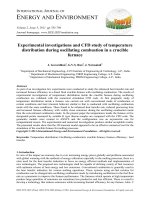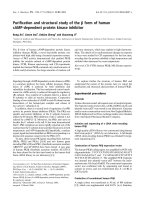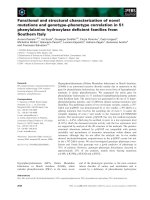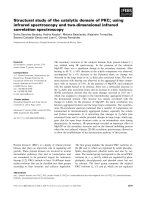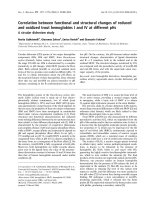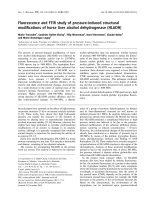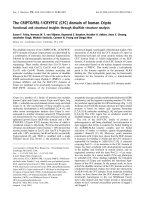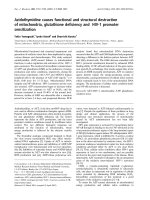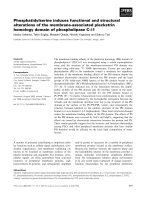Functional and structural study of singapore grouper iridovirus ORF086R
Bạn đang xem bản rút gọn của tài liệu. Xem và tải ngay bản đầy đủ của tài liệu tại đây (2.68 MB, 89 trang )
FUNCTIONAL AND STRUCTURAL STUDY
OF
SINGAPORE GROUPER IRIDOVIRUS ORF086R
YAN BO
NATIONAL UNIVERSITY OF SINGAPORE
2011
FUNCTIONAL AND STRUCTURAL STUDY
OF
SINGAPORE GROUPER IRIDOVIRUS ORF086R
YAN BO
(B.Sc., Xiamen University,China)
A Thesis Submitted For The Degree Of Master Of Science
Department of Biological Sciences
National University of Singapore
2011
Acknowlegments
I would like to extend my deepest appreciation to my supervisor, Professor Hew Choy Leong. I am
indebted for his patient guidance, encouragement and excellent advice throughout this study.
My sincere thanks to Ministry of Education of Singapore for providing me the research scholarship
to pursue my study.
I would like to extend my deep gratitude Dr. Wu Jinlu, who has given me this invaluable advice
through out my two years’ study.
I would like to extend my special thanks to Dr.Adam Yuan Yuren for his collaboration on protein
purification and crystal screening. I would like to thank Dr Fan Jingsong and Dr Yang Daiwen for
the data collection and discussion on NMR work.
I would like to thank all other members and ex-members of Functional Genomics Lab 4 for the
friendship and assistance.
Finally, I take this opportunity to express my profound gratitude to my beloved parents, who
support and help me during my study. Special thanks to my boy friend for his encouragement in
my difficult period.
i
Table of contents
Acknowledgement----------------------------------------------------------------------------------------------i
Table of contents-----------------------------------------------------------------------------------------------ii
Summary--------------------------------------------------------------------------------------------------------vi
List of Figures-------------------------------------------------------------------------------------------------vii
List of Tables---------------------------------------------------------------------------------------------------ix
List of Abbreviations------------------------------------------------------------------------------------------x
CHAPTER 1 Introduction & Literature Review
1.1 Introduction to virus---------------------------------------------------------------------- ------------2
1.2 Introduction to Iridovirus----------------------------------------------------------------------------2
1.3 Replication cycle of iridovirus-----------------------------------------------------------------------5
1.4 Introduction and Research Progress of Singapore Grouper Iridovirus---------------------7
1.4.1. Introduction of SGIV-----------------------------------------------------------------------------7
1.4.2 Structure of SGIV-----------------------------------------------------------------------------------8
1.4.3 Physical properties of SGIV-----------------------------------------------------------------------9
1.4.4 Temporal and differential stage gene expression of SGIV----------------------------------10
1.5 Introduction to Morpholino oligonucleotides technology-------------------------------------11
1.5.1 Gene knock-down---------------------------------------------------------------------------------11
1.5.2 Gene knock down by Morpholino--------------------------------------------------------------11
1.5.2.1 Morpholino-----------------------------------------------------------------------------------11
1.5.2.2 Mechanism of MO gene knock down-----------------------------------------------------13
ii
1.6 Introduction to NMR spectroscopy----------------------------------------------------------------13
1.7 Introduction of circular dichroism----------------------------------------------------------------14
1.8 Introduction of dynamic light scattering--------------------------------------------------------15
1.9 Objectives and significance of this project -----------------------------------------------------16
CHAPTER 2 Methods & Materials
2.1 Molecular biology techniques (DNA related)----------------------------------------------------18
2.1.1 PCR----------------------------------------------------------------------------------------------18
2.1.2 Agarose gel eletrophoresis--------------------------------------------------------------------18
2.1.3 PCR products purification---------------------------------------------------------------------19
2.1.4 Enzyme digestion, dephosphorylation and purification-----------------------------------19
2.1.5 Ligation and transformation------------------------------------------------------------------19
2.1.6 Positive clone screening and plasmid preparation-----------------------------------------20
2.1.7 Cycle sequencing reaction--------------------------------------------------------------------20
2.1.8 Sequence determination-----------------------------------------------------------------------21
2.1.9 Transformation---------------------------------------------------------------------------------21
2.2 Protein techniques------------------------------------------------------------------------------------21
2.2.1 Small scale test---------------------------------------------------------------------------------21
2.2.2 Large scale production of recombinant protein--------------------------------------------22
2.2.3 Cells lysis----------------------------------------------------------------------------------------22
2.2.4 His column purification-----------------------------------------------------------------------23
2.2.5 Ion exchange purification---------------------------------------------------------------------23
2.2.6 Size exclusion chromatography -------------------------------------------------------------23
2.2.7 Twenty-five crystal screening kits ----------------------------------------------------------24
iii
2.2.8 SDS-PAGE--------------------------------------------------------------------------------------24
2.2.9 Production of polyclonal antibodies--------------------------------------------------------25
2.3 Knock down platform methods--------------------------------------------------------------------25
2.3.1Grouper embryonic cell line (GE cell line) and subculture -------------------------------25
2.3.2 AsMO Design and Transfection -------------------------------------------------------------25
2.3.3 Western blot ------------------------------------------------------------------------------------27
2.3.4 TCID50---------------------------------------------------------------------------------------------------------------------------------------- 27
2.3.5 Transmission Electron Microscopy----------------------------------------------------------28
2.4 Materials
2.4.1 Enzymes and other proteins-------------------------------------------------------------------29
2.4.2 Kit and reagents--------------------------------------------------------------------------------29
2.4.3 Culture medium--------------------------------------------------------------------------------29
2.4.3.1 LB medium--------------------------------------------------------------------------29
2.4.3.2 2X YT Media-----------------------------------------------------------------------29
2.4.4 Antibiotic stock solution----------------------------------------------------------------------30
2.4.4.1 IPTG stock solution-----------------------------------------------------------------30
2.4.4.2Ampicillin stock solution-----------------------------------------------------------30
2.4.5 Buffer for protein purification----------------------------------------------------------------30
2.4.5.1Buffers for Ni-NTA purification under native conditions----------------------30
2.4.5.2Buffers for ion exchange purification---------------------------------------------31
2.4.5.3 Buffers for gel filtration purification---------------------------------------------31
2.4.6 E.coli strains------------------------------------------------------------------------------------31
iv
Charpter3 ORF086R Functional & Structural Study
3.1 Introduction-----------------------------------------------------------------------------------------------33
3.2 Gene construction, expression and purification---------------------------------------------------35
3.3 Knockdown Platform Technology for the Studies of ORF086R--------------------------------35
3.3.1 Viral Protein Expression Analysis with Western Blot Assay----------------------------------37
3.3.2 Virus infectivity analysis----------------------------------------------------------------------------38
3.3.3 Effects on other viral proteins expression after ORF086R knockdown ----------------------40
3.3.4 Transmission Electron Microscopy----------------------------------------------------------------41
3.4 Structural study of ORF086R-------------------------------------------------------------------------43
3.4.1 Secondary structure prediction of ORF086R----------------------------------------------------43
3.4.2 ORF086R-pET28a-sumo purification-------------------------------------------------------------44
3.4.3 Crystal seceening of ORF086R-pET28a-sumo--------------------------------------------------47
3.4.4 Removal of sumo tag from ORF086R-------------------------------------------------------------48
3.4.5 ORF086R-pET28a-sumo trypsin digestion-------------------------------------------------------49
3.4.6 ORF086R(1-85)-pET28a-sumo Purification-----------------------------------------------------51
3.4.7 Removal sumo tag from ORF086R(1-85)--------------------------------------------------------54
3.4.8 ORF086R(1-85) CD and DLS study---------------------------------------------------------------56
3.4.9 ORF086R(1-85) 1D NMR study-------------------------------------------------------------------58
3.5 Discussion--------------------------------------------------------------------------------------------------60
Reference-------------------------------------------------------------------------------------------------------66
Appendix-------------------------------------------------------------------------------------------------------73
v
Summary
Singapore grouper iridovirus (SGIV) is a major pathogen that causes significant economic losses
in marine farms specially in Singapore and South East Asia.
The virus contains a dsDNA genome of about 140kb predicted to encode 162 open reading
frames(ORFs). Our previous proteomics and transcriptomics study had identified ORF86R as an
immediately early (IE) gene. We hypothesize that ORF086R may play an important role in virus
infection and replication. Both full length and truncated ORF086R were cloned and expressed in E.
coli to get soluble and stable protein for raising antibody and crystal screening. Gene knock-down
platform using morpholino antisense oligonucleotides (MO) was successfully set up in our lab.
Antisense morpholino oligonucleotide (asMOs) was used to knock down ORF86R expression in
grouper embryonic cells. TCID50 and electron microscope were carried out to examine the viral
infectivity and replication. We observed that TCID50 was not reduced and viral morphology was
not affected after the gene knockdown. For the functional study, ORF086R may not play important
role in virus replication and assembly. Circular dichroism (CD) and dynamic light scattering (DLS)
also showed that the protein is likely to be folded. The protein is mainly composed of β-sheet
structures by secondary structure prediction. Ongoing experiments are focused on identification of
ORF086R’s binding partners and optimization of its crystallization conditions, which may help us
to understand how this viral IE gene interacts with host factors and facilitates its replication.
vi
List of Figures
Figure1.1 Iridovirid replication cycle-----------------------------------------------------------------------6
Figure1.2 SGIV single particle is observed under electron microscopy --------------------------------9
Figure1.3 CD spectroscopy of protein secondary structure----------------------------------------------15
Figure3.1 PSI blast among ORF086R and other iridovirus familiy members------------------------34
Figure3.2 Expression of ORF086R-pET15b-------------------------------------------------------------35
Figure3.3 Western blot assay of ORF086R in virus infected cells-------------------------------------36
Figure3.4 Solubility of ORF086R expressed in different vectors--------------------------------------37
Figure3.5 Western blot assay of ORF086R knock-down time course study--------------------------38
Figure3.6 Virus infectivity test of TCID50 -----------------------------------------------------------------39
Figure3.7 Western blot assay of ORF086R knockdown at 48h.p.i.------------------------------------40
Figure3.8 Western blot assay of other viral proteins-----------------------------------------------------41
Figure3.9 TEM study of ORF086R knockdown---------------------------------------------------------42
Figur3.10 Prediction of ORF086R secondary structure-------------------------------------------------43
Figure3.11 ORF086R-pET28a-sumo His column purification------------------------------------------45
Figure3.12 ORF086R-pET28a-sumo gel filtration purification-----------------------------------------46
Figure3.13 Tiny crystals of ORF086R-pET28a-sumo---------------------------------------------------47
Figure3.14 Removal sumo tag of ORF086R by sumo protease-----------------------------------------49
Figure3.15 ORF086R-pET28a-sumo trypsin digestion--------------------------------------------------50
Figure3.16 ORF086R(1-85)-pET28a-sumo His column purification----------------------------------52
Figure3.17 ORF086R(1-85)-pET28a-sumo His column purification----------------------------------53
Figure3.18 Removal sumo tag from ORF086R (1-85) by sumo protease ----------------------------54
vii
Figure3.19 ORF086R(1-85) purification-------------------------------------------------------------------55
Figure3.20 CD study of ORF086R(1-85)------------------------------------------------------------------57
Figure3.21 DLS study of ORF086R(1-85)----------------------------------------------------------------57
Figure3.22 1D NMR study of ORF086R------------------------------------------------------------------59
viii
List of Tables
Table1.1 Current classification of the Family Iridoviridae-----------------------------------------------4
Table1.2 The structures of three major gene knock-down types----------------------------------------12
Table2.1 The sequences of Morpholinos for knock-down experiments-------------------------------26
Table3.1 Prediction of ORF086R secondary structure---------------------------------------------------43
ix
List of Abbreviations
1D
one-dimensional
2D
two-dimensional
3D
three-dimensional
aa
amino acid
AcMNPV
Autographa californica Nucleopolyhedrovirus
asMO
antisense morpholino
ATCV-1
Acanthocystis turfacea Chlorella virus 1
ATP
adenosine triphosphate
BmNPV
Bombyx mori NPV
BVDV-1
Bovine diarrhea virus 1
CNPV
Canarypox virus
DNA
deoxyribonucleic acid
dsDNA
double-stranded DNA
DTT
dithiothreitol
E.coli
Escherichia coli
EDTA
ethylenediamine tetraacetic acid
EM
electron microscope
FBS
fetal bovine serum
FV3
frog virus 3
GIV
Grouper Iridovirus
GST
glutathione S-transferase
x
HCMV
human cytomegalovirus
HSV
herpes simplex virus
ICTV
the International Committee on Taxonomy of Virus
IIV-6
invertebrate iridovirus 6
ISKNV
infectious spleen and kidney necrosis virus
IPTG
isopropyl-β-D-thiogalactopyranoside
kbp
kilo base pair
kDa
kilo Dalton
LC
liquid chromatography
LB
luria- Bertani
MALDI
matrix assisted laser desorption/ionization
MEM
minimal essential medium
MOI
multiplicity of infection
MS
mass spectrometry
MW
molecular weight
NMR
nuclear magnetic resonance
ORF
open reading frame
PAGE
polyacrylamide gel electrophoresis
PBS
phosphate buffered saline
PCR
polymerase chain reaction
PDVF
polyvinylidene fluoride
RBIV
rock bream iridovirus
SDS
sodium dodecyl sulfate
xi
SGIV
Singparore Grouper Iridovirus
ssDNA
single-stranded DNA
SptlNPV
Spodoptera litura NPV
TCID
tissue culture infection dose
TEM
transmission electron microscope
TTBS
Tris-Tween Buffered Saline
TFV
tiger frog virus
YT
yeast extract tryptone
xii
Chapter 1
Introduction & Literature Review
1.1 Introduction to virus
A virus is a biological agent that reproduces inside the cells of living hosts. Most viruses
are too small to be seen directly with a light microscope. Viruses infect almost all types
of organisms. After Martinus Beijerinck initially discovered the tobacco mosaic virus in
1898, over 2,000 species of viruses have been found. A host cell is forced to produce
many thousands of identical copies of the original virus once infected. New viruses are
assembled in the infected host cells and later secreted.
Viruses are composed of protein coats (virus capsids) and genomic contents. The
genomic contents inside of the virus could be either DNA or RNA. Virues can be
classified into two major groups, DNA viruses and RNA viruses. DNA viruses contain
both single-stranded DNA (ssDNA) viruses and double-stranded DNA (dsDNA) viruses.
The dsDNA viruses have more than 20 families.
1.2 Introduction to Iridovirus
The family Iridoviridae (i.e. the iridoviruses family) is a member of the DNA virus
families. It consists of large cytoplasmic DNA viruses that infect insects and coldblooded vertebrates. Smith and Xeros discovered the first iridovirus in 1954. More than
2
100 iridoviruses have been isolated now. There are five genera: Iridovirus,
Chloriridovirus, Lymphocystivirus, Megalocytivirus and Ranavirus (Williams et al.,
2006). They have icosahedral symmetry. The virion is made up of three parts; an outer
capsid, an intermediate lipid membrane, and a central core containing DNA-protein
complexes. Some of the viruses also have an outer envelope.
Iridoviruses are icosahedral viruses with 120 to 300 nm in diameter. The genome of
iridoviruses is between 100 and 210 kbp and composed of double-stranded linear DNA.
The two genera-Ranavirus and Lymphocystivirus only infect cold blooded animals, such
as fish, amphibians, and reptiles while the genus-Megalocytivirus only infects marine fish
in South East Asia(Chinchar et al., 2008). However, several isolates have not been
characterized to a sufficient level to be assigned to any genus. Several species under the
family Iridoviridae are listed in Table 1.1(Chinchar et al., 2008)
3
Table 1.1 Current classification of the Family Iridoviridae
Tipula paluosa IV
Iridovirus
Sericesthis pruinosa IV
Chilo suppessalis IV
Choriridovirus
Acdes taeniorhynchus IV
Acedes cantans IV
Frog virus 3
Frog virus 1, 2, 5-24
Ranavirus
Singapore grouper iridovirus
Ambystoma tigrinum virus
Iridoviridae
Tiger frog virus
Lymphocystis disease virus type 1
Lymphocystivirus
2Lymphocystis disease virus type c
Octopus vulgaris disease virus
Red Sea bream iridovirus
Megaloctivirus
Taiwan grouper iridovirus
Olive flounder iridovirus
Rock bream iridovirus
Unassigned
White sturgeon iridovirus
(Chinchar et al., 2008)
4
1.3 Replication cycle of iridovirus
It is reported that the iridovirus replication mainly comes from the study of FV-3 (Figure
1.1). The virus particle binds to a currently unknown cellular receptor of host cells
(Chinchar et al., 2008). After binding, enveloped virus enter into cell via receptor
mediated endocytosis. After entry, virion is uncoated to release the central protein/DNA
core . The protein/DNA complex core makes its way into the nucleus. Early viral gene
transcription and first phase DNA synthesis are two major events in the nucleus at the
early stage infection (Williams et al., 2006). Newly synthesized viral DNA is exported
out of the nucleus into the cytoplasm (Goorha, 1982), where further DNA replications
take place. Large concatameric DNA structures are formed through recombination
between unit viral genome, which represents second phase DNA replication (Goorha and
Dixit, 1984). Late stage gene transcription is also carried out in cytoplasm. The DNA and
late viral transcripts encoded viral proteins enter cytoplasmic virion assembly site (VAS),
where viral DNA and proteins assemble into mature virions. The mature viruses form in
to paracrystalline array. Some of them are released through viron budding, most of the
mature viruses came out with cells released.
Until now, in vertebrate iridovirus, SGIV is the only one that lacks a DNA
methyltransferase which suggested that methylation is not an essential step for viral
infection (Song et al., 2004). Events in virus replication are summarized in Figure 1.1
(Chinchar et al., 2008).
5
Figure 1.1 Iridovirdae replication cycle. The life cycle of frog virus 3 (FV3) is illustrated.
(Chinchar et al., 2008)
6
1.4 Introduction and Research Progress of Singapore Grouper
Iridovirus (SGIV)
1.4.1 Introduction of SGIV
It is reported that a novel member of Ranavirus, Singapore grouper iridovirus (SGIV),
caused significant economic losses in Singapore marine net cage farm in 1994 (Chua et
al., 1994). It causes “Sleepy Grouper Disease” (SGD) in grouper fish (Chua et al., 1994,
Qin et al., 2001, Song et al., 2004). SGIV was isolated from brown groupers in 1998 (Qin
et al., 2001). The genomic DNA of SGIV was sequenced in 2004 (Song et al., 2004).
SGIV genome is 140,131 nucleotide bp long, with 17 repetitive regions covering 2.6% of
SGIV genome and is also circularly permuted and terminally redundant. Totally, 162
presumptive open reading frames (ORF) have been annotated from sense and antisense
strand of SGIV genome (Song et al., 2004). Among them, 24 proteins have been
identified with significant homology to known proteins, another 66 with sequence
similarities with unknown proteins of Iridovirdae family or have a relative low homology
with known proteins, the remaining 72 putative proteins have no significant homology in
the current database (Song et al., 2004). Previously our lab has identified several SGIV
structural proteins with different proteomics methods (1D SDS-PAGE MALDI TOF
PMF approach, 1D SDS-PAGE MALDI-TOF MS/MS approach, LC-MALDI shotgun
approach) (Song et al., 2004, Song et al., 2006) and iTRAQ approach(Chen& Tran et al,
2008).
7
For the first two methods, the purified SGIV virions were treated with SDS-loading dye
and resolved with 1D SDS-PAGE, the protein bands were incised from gel and analyzed
with mass spectrometry. For PMF approach, only peptide information was captured by
MS machine and for MS/MS approach, the peptides with high signal intensity were
further analyzed and its amino acid sequence was further identified. For the third method,
purified virions were treated with sonication and the peptide mixtures from purified
virion were separated with a liquid chromatography. The different peptide fractions were
analyzed by MALDI-TOF MS/MS. For the last method, iTRAQ is a proteomic method
which is sensitive and can detect small amount of proteins. Uninfected cells and infected
cells were treated with lysis buffer, quantitatively analysis with iTRAQ machine on the
same amount of total proteins. It can analyze the protein amount in parallel, which may
suggest protein interactions.
Up to date, seventy-two proteins were identified by the four approaches and among them
seventeen proteins were confirmed by all MS approaches which suggested that they are
abundant structural proteins. (Song et al., 2004, Song et al., 2006).
1.4.2 Structure of SGIV
Sucrose gradient ultracentrifugation has been developed for the purification of SGIV
(Qin et al., 2003). Most of the virus was suspended at the boundary layer between 40%
and 50% sucrose (an equilibrium density banding) with this approach. The virus was
negative stained and examined under electron microscopy. The viral particle revealed a
8
three-layer membrane structure with an inner electron-dense core. The average size of
SGIV was also determined by electron microscopy and was estimated as 200±13nm. The
SGIV formed a well-defined hexagonal contour, suggesting that the three-dimensional
structure of the SGIV is an icosahedral particle (Qin et al., 2001). SGIV particle is
showed in Figure 1.2.
Figure 1.2 SGIV single particle is observed under electron microscopy. It is a welldefined hexagonal contour (Qin et al., 2001).
1.4.3 Physical properties of SGIV
One important aspect of the SGIV is its physicochemical properties (Qin et al., 2001).
The infectivity of the SGIV isolate maintained at a high titer of 106.0 TCID50 ml-1,
propagated continuously in a grouper embryonic cell line. Nevertheless, the infectivity
dropped dramatically when treated by high temperature at 56 ºC for 30 min. Under an
acidic environment with 0.1 M citrate buffer (pH 3.0), the SGIV almost lost all its
infectivity in culture media. Through the two method treatment, the titer was reduced
9
dramatically from 107.0 to 103.0 TCID50 ml-1. The SGIV was affected with low
concentration of 5-iodo-2-deoxyuridine treatment (IUdR, 10 µM), suggesting that the
virus possessed a DNA genome. Elucidation of physicochemical properties of the SGIV
has facilitated us to monitor the fish disease. Besides, all the above characteristics
provide the evidence for the classification of SGIV within the virus kingdom. However,
the genetic structure of the virus is a conclusive evidence to determine the member of the
family Iridoviridae.
1.4.4 Temporal and differential stage gene expression of SGIV
A DNA microarray was generated for the SGIV genome to analyze the expression of its
predicted ORFs. At different time point, the noninfected and infected cells of SGIV
infection were collected and treated with cycloheximide and aphidicoline to study the
temporal stage of gene expression (such as Immediate Early, Early and Late genes). A
translation inhibitor, Cytoheximide, blocked DE/L genes transcription but not IE genes
transcription. A DNA replication inhibitor, Aphidicoline, blocked L genes transcription
but not IE/DE genes transcription (Chen et al., 2006). The DNA microarray data was
verified with real-time RT-PCR studies (Chen et al., 2006).
A microarray study showed that the gene transcription of SGIV is in a temporal sequence
which can be clustered into three coordinated phases: (1) immediate early (IE): 28 ORFs;
(2) delayed early/early (DE/E): 49 ORFs; (3) late (L): 37 ORFs (Chen et al., 2006). 114
10
of all 162 predicated ORFs were classified and the rest could not be classified. These
results provide important insights into the replication and pathogenesis of iridoriviruse.
1.5 Introduction to Morpholino oligonucleotides technology
1.5.1 Gene knock-down
Gene knock-down is a technique in which an organism is genetically modified to reduce
the expression of one or more genes through the insertion of an agent such as a short
DNA or RNA olionucleotide with a sequence complementary to an active gene or its
mRNA transcripts (Summerton, 2007).
There are three major gene knock-down types: 1) phosphorothiotate-linked DNA(SDNA); 2) short interfering RNA (siRNA); 3) Morpholino. The structure of these 3 types
of gene knock-down are illustrated in Table 1.2 (Summerton, 2007).
1.5.2 Gene knock down by Morpholino
1.5.2.1 Morpholino
Morpholinos or morpholino antisense oligonucleotides or oligos are called MO in short
form. MO is a gene knock-down agent which consists of short chains of about 25
morpholino subunits. Each morpholino subunit contains a nucleotide base, a morpholine
ring and a non-ionic phosphorodiamidate inter-subunit linkage (Table 2) (Summerton,
2007).
11
